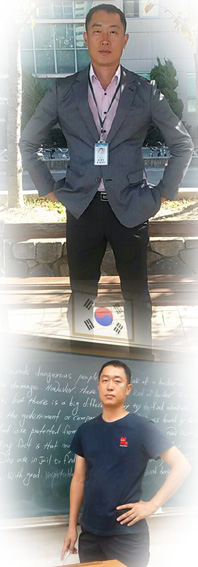2010년 수능 외국어 영역 27번 정답 및 해설 - 송곡닷컴(songgok.com)
27. 다음 글의 빈칸에 들어갈 말로 가장 적절한 것을 고르시오.
The human auditory system . A psychologist named Richard Warren demonstrated this particularly well. He recorded a sentence and cut out a piece of the sentence from the recording tape. He replaced the missing piece with a burst of static of the same duration. Nearly everyone who heard the altered recording could report that they heard both a sentence and static. But a majority of people could not tell where the static was! The auditory system had filled in the missing speech information, so that the sentence seemed uninterrupted. Most people reported that there was static and that it existed apart from the spoken sentence. The static and the sentence formed separate perceptual streams due to differences in the quality of sound that caused them to group separately. * static: 잡음(雜音)
① recognizes incorrect pronunciation
② plays an important role in speaking
③ has its own version of perceptual completion
④ reacts differently according to different languages
⑤ analyzes auditory and visual cues at the same time
1. 내용풀이
사람들의 청각은 문장을 들을 때 잡음으로 끊긴 부분을 채워서 듣는 특성이 있음을 설명한 글이다. 따라서 빈칸에는 나름대로의 지각의 완성 방식을 갖는다(has its own version of perceptual completion)는 내용이 필요하다.
① 부정확한 발음을 인식한다 ② 말하기에 있어서 중요한 역할을 수행한다 ④ 언어에 따라 다르게 반응한다 ⑤ 청각적 단서와 시각적 단서를 동시에 분석한다
2. 구문해설
① [The human auditory system has its own version of perceptual completion. A psychologist (named Richard Warren) demonstrated this particularly well.] ※ perceptual completion 지각의 완성 →인간의 청각 체계는 그 나름대로의 지각의 완성 방식(version)을 지니고 있다. Richard Warren이라는 이름의 한 심리학자는 이를 특별히 잘 입증했다.
② [He recorded a sentence and cut out a piece of the sentence from the recording tape. He replaced the missing piece with a burst of static of the same duration.] ※ *replace ⓐ with ⓑ: ⓐ를 ⓑ로 대체하다
※the missing piece: 없어진 부분 ※duration 지속(시간, 기간) ※a burst of static of the same duration: 같은 지속시간을 갖는(같은 시간동안 지속되는) 잡음의 분출 → 그는 한 문장을 녹음한 후 녹음테이프에서 그 문장의 일부를 떼어냈다. 그는 비어있는 부분을 같은 시간동안 지속되는 잡음의 분출로 대체했다.
③ [Nearly everyone (who heard the altered recording) could report that they heard both a sentence and static. But a majority of people could not tell where the static was!]
※the altered recording:변경된 녹음내용 ※ a majority of: 다수의 ~ ※where the static was:간접의문문 어순 주의
→ 변경된 녹음 내용을 들은 거의 모든 사람들은 문장과 잡음을 모두 들었다고 알릴 수 있었다. 하지만 대다수의 사람들은 잡음이 어디에서 들렸는지를 말할 수 없었다.
④ [The auditory system had filled in the missing speech information, so that the sentence seemed uninterrupted.] ※the missing speech information: 없어진 발화 정보 ※ ,so that: 그 결과, 즉, 그래서 → 청각 체계가 사라진 발화정보를 채워서 그 문장은 중단되지 않은 것처럼 보인 것이다
⑤ [Most people reported that there was static and that it existed apart from the spoken sentence.] ※apart from ~ ~와 분리되어, ~와는 별도로, ~과는 별개로 ※spoken sentence: 발화된 문장 → 대부분의 사람들은 잡음이 있었고 그것은 발화된 문장과는 분리되어 존재했다고 알렸다
⑥ [The static and the sentence formed separate perceptual streams / due to differences in the quality of sound / that caused them to group separately.]
※separate perceptual streams:분리된 지각의 흐름 ←여기서 separate는 형용사(분리된)로 쓰였음. ※ due to ~ 때문에(owing to = thanks to = because of) *group 무리를 형성하다, 집단을 이루다 ※that은 관계대명사로 선행사는 differences in the quality of sound(음질의 차이)이며, them은 The static and the sentence(잡음과 문장)을 가리키고 있네요^^ → 잡음과 문장이 음질의 차이 때문에 분리된 집단을 이루어서 분리된 지각의 흐름을 형성한 것이다.
3. 단어정리
*auditory 청각적인 *psychologist 심리학자 *demonstrate 입증하다, 논증하다, 증명하다 *replace ⓐ with ⓑ: ⓐ를 ⓑ로 대체하다 *burst 분출, 폭발, 파열하다, 폭발하다 *static 잡음, 고정된, 정지상태의 *duration 지속(시간, 기간) *alter 바꾸다, 변경하다 *fill in 메우다, 채우다 *uninterrupted 중단되지 않은, 방해받지 않은 *apart from ~ ~와 분리되어, ~와는 별도로 *perceptual 지각의, 지각력의 *due to ~ 때문에 *group 무리를 형성하다, 집단을 이루다 *pronunciation 발음 * analyzes:분석하다 *perceptual completion 지각의 완성 *play a role(part) in: ~에 역할을 하다 *visual cues:시각적인 단서
4. 전문해석
인간의 청각 체계는 그 나름대로의 지각의 완성 방식을 지니고 있다. Richard Warren이라는 이름의 한 심리학자는 이를 특별히 잘 입증했다. 그는 한 문장을 녹음한 후 녹음테이프에서 그 문장의 일부를 떼어냈다. 그는 비어있는 부분을 같은 시간동안 지속되는 잡음의 분출로 대체했다. 변경된 녹음 내용을 들은 거의 모든 사람들은 문장과 잡음을 모두 들었다고 알릴 수 있었다. 하지만 대다수의 사람들은 잡음이 어디에서 들렸는지를 말할 수 없었다. 청각 체계가 사라진 발화정보를 채워서 그 문장은 중단되지 않은 것처럼 보인 것이다. 대부분의 사람들은 잡음이 있었고 그것은 발화된 문장과는 분리되어 존재했다고 알렸다. 잡음과 문장이 음질의 차이 때문에 분리된 집단을 이루어서 분리된 지각의 흐름을 형성한 것이다.
.gif)


.gif)

